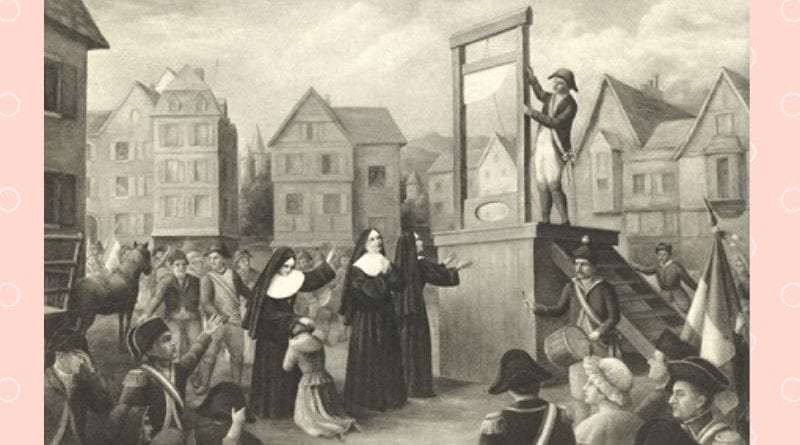Skip to content

In this great country, it’s not a crime to be a Christian – at least not yet. But the left is working on it. Free expression of religion is not just shunned, it is ridiculed and mocked. Anti-Christian bigotry is the only form of acceptable intolerance remaining in this country – to be encouraged and incited by our “tolerant” liberal friends in academia, the media, and entertainment.
Christian principles were foundational to the American Republic. Yet what matters to the left is silencing the Christian influence of this nation. The battle to destroy Christianity is really the battle to destroy America. The intolerant left is replacing the structure of an orderly and benevolent norm with falsehoods, distortions, intimidation, and violence. Unfortunately, traditional American Christians have been on the losing end of the culture war for a long time
The Martyrs of Compiègne
.
Martyrs of the French Revolution

.
On the day, 17 July, in 1794, the Holy, Roman Catholic Church gained 16 Virgin Martyrs, the Discalced Carmelites of Compiegne, victims of the Masonic Revolution in France. These brave and pure women, by their holy sacrifice purchased the end of the bloody tide of public beheadings. Although the public display of gory beheadings had run its course, the Satanic Revolution has, in various forms, continued on up to the present time. We do well to heed the example of these brave martyrs, for we may sooner or later be called upon to defend the faith ourselves.
2019-06-17-13_05_43-Christianity-is-under-siege-in-America-Capitol-Hill-Outsider.
Rekindle our ardor, our bodies are the Lord’s,
We climb, we climb the scaffold and give ourselves back to the Victor.
.
THE SIXTEEN CARMELITE MARTYRS OF COMPIEGNE
.
The French Revolution reveals the titanic struggle between good and evil. During the terror, over 40,000 Frenchmen were executed just for holding fast to the Catholic Faith and objecting to the worst excesses of the Committee of Public Safety. The blood lost in the years of 1792-1794 staggers the imagination even in the retelling and the campaign against the Church was as diabolical as it was cruel.
.
Contemplative religious communities had been among the first targets of the fury of the French Revolution against the Catholic Church. Less than a year from May 1789 when the Revolution began with the meeting of the Estates-General, these communities had been required by law to disband. But many of them continued in being, in hiding. Among these were the community of the Carmelite nuns of Compiegne, in northeastern France not far from Paris — the fifty-third convent in France of the Carmelite sisters who followed the reform of St. Teresa of Avila, founded in 1641, noted throughout its history for fidelity and fervor. Their convent was raided in August 1790, all the property of the sisters was seized by the government, and they were forced to discard their habits and leave their house. They divided into four groups which found lodging in four different houses all near the same church in Compiegne, and for several years they were to a large extent able to continue their religious life in secret. But the intensified surveillance and searches of the “Great Terror” revealed their secret, and in June 1794 most of them were arrested and imprisoned.
.
They had expected this; indeed, they had prayed for it. At some time during the summer of 1792, very likely just after the events of August 10 of that year that marked the descent into the true deeps of the Revolution, their prioress, Madeleine Lidoine, whose name in religion was Teresa in honor of the founder of their order, had foreseen much of what was to come. At Easter of 1792, she told her community that, while looking through the archives she had found the account of a dream a Carmelite had in 1693. In that dream, the Sister saw the whole Community, with the exception of 2 or 3 Sisters, in glory and called to follow the Lamb. In the mind of the Prioress, this meant martyrdom and might well be a prophetic announcement of their fate.
.
Mother Teresa had said to her sisters: “Having meditated much on this subject, I have thought of making an act of consecration by which the Community would offer itself as a sacrifice to appease the anger of God, so that the divine peace of His Dear Son would be brought into the world, returned to the Church and the state.” The sisters discussed her proposal and when the news of the September massacres came, mingling glorious martyrdom with apostasy, the community made their offering. In July, 1794 it was to be accepted.
.
After their lodgings were invaded again in June, their devotional objects shattered and their tabernacle trampled underfoot by a Revolutionary who told them that their place of worship should be transformed into a dog kennel, the Carmelite sisters were taken to the Conciergerie prison, where so many of the leading victims of the guillotine had been held during their last days on earth. There they composed a canticle for their martyrdom, to be sung to the familiar tune of the Marseillaise. The original still exists, written in pencil and given to one of their fellow prisoners, a lay woman who survived.
.
“Give over our hearts to joy, the day of glory has arrived,
Far from us all weakness, seeing the standard come;
We prepare for the victory, we all march to the true conquest,
Under the flag of the dying God we run, we all seek the glory;
Rekindle our ardor, our bodies are the Lord’s,
We climb, we climb the scaffold and give ourselves back to the Victor.
.
O happiness ever desired for Catholics of France, To follow the wondrous road
Already marked out so often by the martyrs toward their suffering,
After Jesus with the King, we show our faith to Christians,
We adore a God of justice; as the fervent priest, the constant faithful,
Seal, seal with all their blood faith in the dying God….
.
Holy Virgin, our model, August queen of martyrs, deign to strengthen our zeal
And purify our desires, protect France even yet, help; us mount to Heaven,
Make us feel even in these places, the effects of your power. Sustain your children,
Submissive, obedient, dying, dying with Jesus and in our King believing.”
.
On July 17 the sixteen sisters were brought before Fouquier-Tinville. All cases were now being disposed of within twenty-four hours as Robespierre had wished; theirs was no exception. They were charged with having received arms for the emigres; their prioress, Sister Teresa, answered by holding up a crucifix. “Here are the only arms that we have ever had in our house.” They were charged with possessing an altar-cloth with designs honoring the old monarchy (perhaps the fleur-de-lis) and were asked to deny any attachment to the royal family. Sister Teresa responded: “If that is a crime, we are all guilty of it; you can never tear out of our hearts the attachment for Louis XVI and his family. Your laws cannot prohibit feeling; they cannot extend their empire to the affections of the soul; God alone has the right to judge them.” They were charged with corresponding with priests forced to leave the country because they would not take the constitutional oath; they freely admitted this. Finally they were charged with the catchall indictment by which any true Catholic in France could be guillotined during the Terror: “fanaticism.” Sister Henriette, who had been Gabrielle de Croissy, challenged Fouguier-Tinvile to his face: “Citizen, it is your duty to respond to the request of one condemned; I call upon you to answer us and to tell us just what you mean by the word ‘fanatic.’” “I mean,” snapped the Public Prosecutor of the Terror, “your attachment to your childish beliefs and your silly religious practices.” “Let us rejoice, my dear Mother and Sisters, in the joy of the Lord,” said Sister Henriette, “that we shall die for our holy religion, our faith, our confidence in the Holy Roman Catholic Church.”
.
In the interval between their condemnation and execution the nuns asked for a pail of hot water to wash their soiled clothes. They doffed their civilian garb and put on their religious habits, which were made so as to facilitate the work of the executioner. They did this in order to give witness to their religious profession. Here mention must be made of a group of Benedictine sisters who met the Carmelites in prison after their condemnation to death. They were later to testify to the faith and fervor of the Carmelites in their last hours. Later when the Benedictines were told to remove their religious habits they protested that they had brought no other clothing. To comply with the prison order they were given the garments discarded by the Carmelites, subsequently they were released through diplomatic negotiations and brought their prison garments with them as souvenirs. They are still preserved as precious relics in the Benedictine convent of Stanbrook.
.
With a roll of drums, the cart bearing the condemned nuns to execution emerged from the prison courtyard. It was the last cart in the cortege. Along the route the nuns were heartened to see among the onlookers their faithful and devoted chaplain Fr. de la Marche. As he raised his hand in blessing Mother Teresa intoned the Miserere and the nuns took up the chant. After the Miserere the prayers for the recommendation of the dying were recited together with other hymns and prayers. These included the Te Deum and the Salve Regina. Finally as the cortege turned into the Barriere de Vincennes (the modern Place de la Nation) where the platform with the guillotine was erected. At this point they began intoning the the Veni Creator.
.
In the hush that had fallen on the onlookers beside the guillotine the only voices to be heard were those of the praying nuns. Fr. de la Marche later related how one of the nuns remembered that she had not finished the Office of the day and said to Mother Teresa, “Have no worry,” the latter replied, “we shall recite the Office together when we get to heaven.” At the foot of the scaffold the nuns in turn knelt before their Prioress and asked her permission to die. They kissed her scapular and a little statue of Our Lady she held out to each one as they renewed their vows for the last time on earth. As they awaited their turn to be executed they chanted the Laudate Dominum, the Salve Regina and the Magnificat.
.
The soldiers had no need to help Constance, the novice, up the steps of the scaffold, for she ran up the steps like a young bride eager to meet her bridegroom. She placed her head willingly on the block and was the first to die a martyr’s death. The two eldest sisters aged seventy-nine and seventy-eight had to be helped on to the scaffold. They thanked their executioners for their help and assured them of their prayers when they came into the presence of the Lord.
.
Sister Teresa, their prioress, obtained permission to go last under the knife. After she had encouraged each of her community and received their vows she knelt down and renewed her religious profession in a clear voice, kissed the statue of Our Lady as the others had done and handed it for safe keeping to a friend who years later returned it to the French Carmelites. With the heroic courage of the mother of the Macchabees she then mounted the scaffold chanting the Salve Regina until her voice was silenced on earth and began the eternal canticle in heaven. It was around 8 pm on a midsummer evening and soon the place was hushed in silence as darkness fell over Paris.
.
Later that evening the brother of one of the martyrs, Sr. Anne Pelleras, a notary, returned home. As he entered the dark hall he noticed a light shining on the wall, a light that followed him up the stairway. As he entered the room where his wife awaited him she asked what was the light that surrounded him. He turned round to see a bright globe that faded gradually. The next day, when he heard of the execution of his sister, he realized that she had been permitted to give this sign of her entry into glory.
.
These sixteen holy Carmelite martyrs have all been beatified by our Holy Father, Pope St. Pius X, on 27 May 1906] which is the last step before canonization. Their names:
.
Sr. Teresa of St. Augustine, Prioress (Lidoine)
Sr. St. Louis (Brideau)
Sr. Anne Marie (Piedcourt)
Sr. Charlotte (Thouret)
Sr. Euphrasia (Brard)
Sr. Henriette (de Croissy)
Sr. Teresa (Hanisset)
Sr. Teresa (Trezel)
Sr. Julia Louise (Neuville)
Sr. M. Henriette (Pelleras)
Sr. Constance (Meunier)
Sr. Mary (Roussel)
Sr. St. Martha (Dufour)
Sr. St Francis de Xavier (Verelot)
Sr. Catherine (Soiron)
Sr. Teresa (Soiron)
.
The bodies of the sixteen martyrs, along with their heads, were taken by carts during the night and thrown into the common pit in the Garden of Picpus, a former Franciscan monastery. Here with thousands of others, the martyrs of Compiegne found their last resting place. Later the area was surrounded by a wall and became the cemetery of Picpus. In time it was bought by a company formed by the relatives of the victims and handed back to the Church. Today marble plaques there carry the names of illustrious and noble families but none more glorious than the sixteen blessed women of Compiegne.
.
It is worth noting that within ten days of the execution of the Carmelites many of those who sat in judgment on them and had them condemned to death were themselves brought before the tribunal and sentenced to death. On July 28th, the head of Robespierre rolled beneath the knife of the guillotine. Others like Foquier-Tinville met a similar fate in due course amid cries of “down with the tyrants, down with the murderers”
.
By the end of August the reign of the guillotine had come to an end. Can we doubt that the brave women of Compiegne had a hand in it? There is nobody so much alive as a dead saint. The death of the Carmelite community was by no means futile or in vain. Their victory is the victory of love over hatred. As Mother Teresa of St. Augustine was wont to say: “Love will always be victorious. The one who loves can do everything.” The events which took place on July 17th, showed once again the insuperable power of the love of Christ.
.
Their feast has since been celebrated by the whole Carmelite Order and by the Archdiocese of Paris on the 17th, the day of their entry into glory.
.
Blessed Carmelites of Compiegne, pray for us!
Like this:
Like Loading...







Thank you for this chilling account of what happened to these true followers of Christ. It brings tears to my eyes as I imagine what they have endured and suffered for our divine redeemer. They were martyrs of the faith as so many known and unknown to this day where christianophobia is rampant throughout the Western world and particularly in France where yesterday the cathedral of Nantes saw its beautiful organ dating back to 1610 burned to ashes by some arsonist not yet found… will he ever be? and reminding us as well of Notre Dame fire…as a symbol of coming persecution for Christians.
This is reminiscent of what happened to 32 nuns from different contemplative orders in Orange in the South of France in the summer of 1794.To prepare for their great sacrifice these nuns prayed continually and in deep silence practicing all the religious virtues as related in the diary of a priest probably abbot Boussier. On their final day on this earth, the community gathered at 5 a.m. to pray for and hour. They recited the Divine Office and the Holy Mass.
At 8 o’clock the Litany of the Saints was recited as a preparation for their own death. Prayers for a general confession were made along with a spiritual communion as a viaticum and they prepared themselves to receive the Extreme Unction. They also renewed their religious vows of baptism; confirmation and holy religion.
At 9 o’clock they were called and left happily for the People’s Court where they would be sentenced to death.
What were the charges brought against them?
The public prosecutor found them all guilty of the same crime, being counter revolutionaries, enemies of liberty and equality and having attempted to overthrow the republic through their fanaticism and superstition, opposing the law, refusing to make the oath of allegiance to the republic, refusing to become citizens, having tried to foment civil war and having conspired against the republic”.
These nuns never complained or expressed any hatred towards their tormenters and accepted their fate.
Another interesting detail in this account is the fact that very often a priest who had refused to take the constitutional oath would be waiting in the wings somewhere in the crowd attending the guillotine ceremony to give his absolution to these poor souls.This secretly administered absolution occurred many times in Paris when the prisoners were taken from the Conciergerie close to Notre Dame to the Place de la révolution as it had been renamed (previously known as Place Louis XV and now Place de la Condorde). This is what happened in particular to a great saint although not yet on the altars Elisabeth the king’s sister who received absolution from a priest hidden on the first floor of a building who appeared at the window while the cart with all the prisoners passed by.
thank you for this important comment